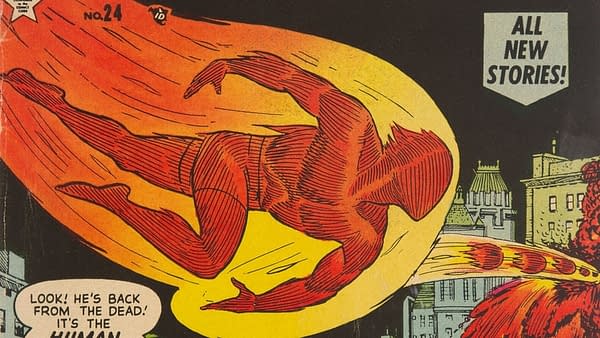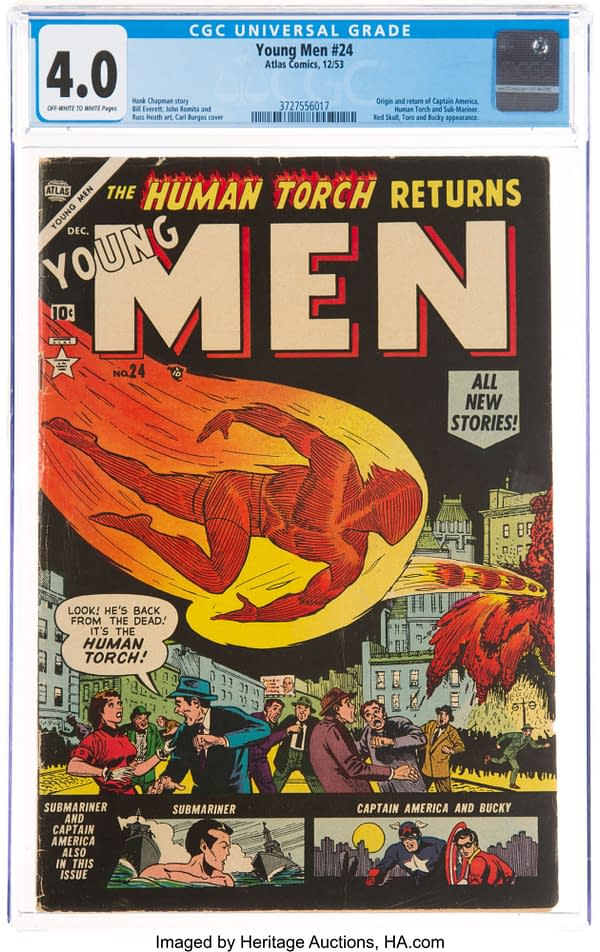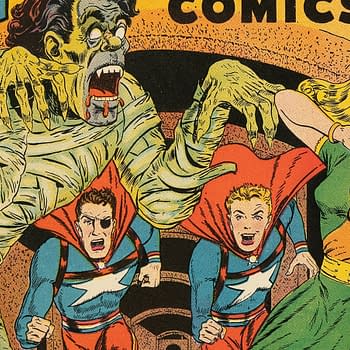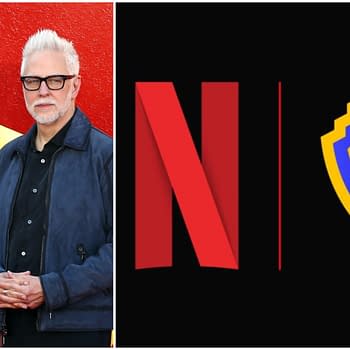Posted in: Comics, Heritage Sponsored, Vintage Paper | Tagged: captain america, human torch, sub-mariner, Young Men
The Heroes Return and Toro was a Foo Fighter: Young Men #24 at Auction
Most vintage collectors are aware that Marvel's Silver Age superhero revival began with Fantastic Four #1 in 1961 — but this was not the first time since Marvel's superheroes ended in the waning days of the Golden Age that such a superhero revival had been attempted at the publisher. There was a previous try at bringing back superheroes during the early Cold War era in a rather unassuming and directionless title called Young Men. Young Men #24 cover-dated December 1953 was the beginning of that short-lived attempt, and there's a Young Men #24 (Atlas, 1953) CGC VG 4.0 Off-white to white pages in today's 2021 August 22-23 Sunday & Monday Comic Books Select Auction #122134 from Heritage Auctions.

Marvel's core superhero characters of Captain America, Human Torch, and the Sub-Mariner disappeared from the newsstands over the course of 1949. Three months after the last issue of Captain America Comics hit the newsstands as a title renamed Captain America's Weird Tales — and with the final issue, Captain America's Weird Tales #75 not even including any Captain America content — Marvel rebooted the title Cowboy Romances as Young Men with issue #4. Young Men was a boy's adventure comic with a very serious edge, and it may have been a propaganda series of sorts with not-infrequent stories about how young men become good soldiers.
The title soon became an actual war comic, renamed as Young Men on the Battlefield with issue #13 in late 1951. Young Men on the Battlefield featured stories of the Korean War, which had started the previous year. By the time the Korean War ended in July 1953, Young Men on the Battlefield's run as a war comic had already concluded six months prior — though Marvel would continue a number of war titles through the end of 1953 and beyond. Meanwhile, the title reverted to simply Young Men again with issue #21 and reverted to its original emphasis on serious boys adventure with an additional hot rod focus. But three issues later in Young Men #24, Captain America, the Human Torch, and the Sub-Mariner all returned for the Cold War era with slightly revised origins and tweaked a bit for the new Cold War era.
The Human Torch story in this issue acknowledges the fact that the character has not been seen in comics since four years prior in 1949 (in Marvel Mystery #92, cover-dated June 1949). His absence is explained with a new story element — it seems that gangsters of a crime syndicate were able to douse him with a fire-suppressing chemical called Solution X-R, and then bury him in the Nevada desert. Upon his escape, he takes on the gang that subdued him before, and these gangsters quickly discover that Solution X-R now has little effect on the Human Torch. As he recaps his origin he also reveals the fascinating tidbit that it was the Human Torch who killed Adolf Hitler by burning him to death. With his dying breath, Hitler told a subordinate that he preferred it be thought that he committed suicide rather than having been defeated and killed by the Human Torch.
It soon emerges in this Young Men #24 Human Torch story that he was buried in Yucca Flat, Nevada under what would later become the Nevada Test Site. Nuclear testing would begin at the site in late 1951, and over the next four decades, the U.S. government conducted a total of 1,021 nuclear tests there. One of these early tests reignited the Human Torch's flame, allowing him to escape his underground doom and making him more powerful than ever before.
The Human Torch's origin-retold moment in this issue also revises his meeting with Toro to having taken place in 1949 — thus allowing the character to have remained a boy three years later, perhaps. Grilling the gangsters who had buried him, the Human Torch discovers that they sold Toro to "a country behind the Iron Curtain". This leads us to a rather incredible historical connection, as according to the story it appears that it was actually Toro who was responsible for the mysterious UFO phenomenon that was in that era called "Foo Fighters". Foo Fighters (and this usage is the actual origin of the term) were mysterious balls of light reported by Air Force pilots both during WWII and in the early 1950s. They were sometimes described as red or orange balls of light that trailed American planes, so fitting Toro into that history was some deft fictional sleight of hand. Notably, it would also appear that this story was written before the end of the Korean War because the Human Torch then travels to Korea to find that Toro has been brainwashed and is now fighting on behalf of the Communists. The Torch is able to snap him out of it with his newly atomic-powered flame.
In the Captain America story in Young Men #24, Steve Rogers is a history professor who recounts his own history to students without revealing that he was a part of that history. Most of his students — and the world — believe that Captain America was a myth or is now dead, except for Bucky Barnes who is now one of his students. Rogers is content to leave it that way, thinking that his work against fascism is done. But soon it transpires that the Red Skull has returned, allying himself with America's "Red Enemies" whom he calls in the story his "friends in the Kremlin". The Red Skull attacks the United Nations, compelling Captain America and Bucky to swing back into action once again.
The Sub-Mariner story in this issue might just be the wildest of these revivals while being incredibly on-the-nose for this early Cold War era. In recounting his origin, the Sub-Mariner is called "the son of a human being as well as a sea-mammal", and the prince of "a tribe of manlike mammals who lived deep in the Antarctic Ocean under the ice fields that cover the South Pole". Somewhat similar to the situation that lead to his revival for the Silver Age, this undersea kingdom was demolished by underwater detonations set off by expeditions sent to the Antarctic to avoid getting stuck in ice floes as they traveled there. And just as he would later do in the Silver Age, the Sub-Mariner would retaliate by attacking New York City. After this "misunderstanding", Prince Namor worked closely with America against the Nazis. In this story, he is called out of retirement by the Navy to investigate a series of ships sinking in the ocean near the Mariana Trench. The Navy thinks this may be Communist aggression, but the Sub-Mariner discovered that it was actually robots from Venus. The irony here is delicious, as alien invasion was often used as a stand-in for Communist invasion in fiction during this period of the Cold War — usually, a little less obviously.
Unfortunately, this attempted superhero reboot at Marvel was short-lived in this era. After five issues of Young Men, three issues of Captain America, three issues of The Human Torch, and ten issues of Sub-Mariner, (the last issue of Sub-Mariner hit newsstands in July 1955), the core heroes disappeared from Marvel once again, and so did the Young Men title. There's a strong indication that publisher Street & Smith picked up the title from Marvel after the superhero reboot in that series ended with Young Men #28. The next month, long-running Street & Smith magazine Air Trails transitioned to Air Trails Hobbies for Young Men, and then simply Young Men over the course of just a few months. The Street & Smith version of the title is not a comic, but rather a science-based hobbyist magazine whose advertiser list is a who's who of major defense contractors, all recruiting these smart young men who grew up on comics into careers in science for military purposes. In that regard, the intent of the new Young Men is not all that dissimilar to Marvel's apparent original focus for the title.
Young Men #24 (Atlas, 1953) CGC VG 4.0 Off-white to white pages. First comic book of Marvel's brief "superhero revival" period that brought back the Human Torch, Captain America, and the Sub-Mariner. Recaps the origins of all three heroes. Hitler and Red Skull appearances. Russ Heath, Bill Everett, and John Romita Sr. art. Overstreet 2021 VG 4.0 value = $846. CGC census 8/21: 6 in 4.0, 41 higher.
View the certification for CGC Certification ID 3727556017 and purchase grader's notes if available.

















